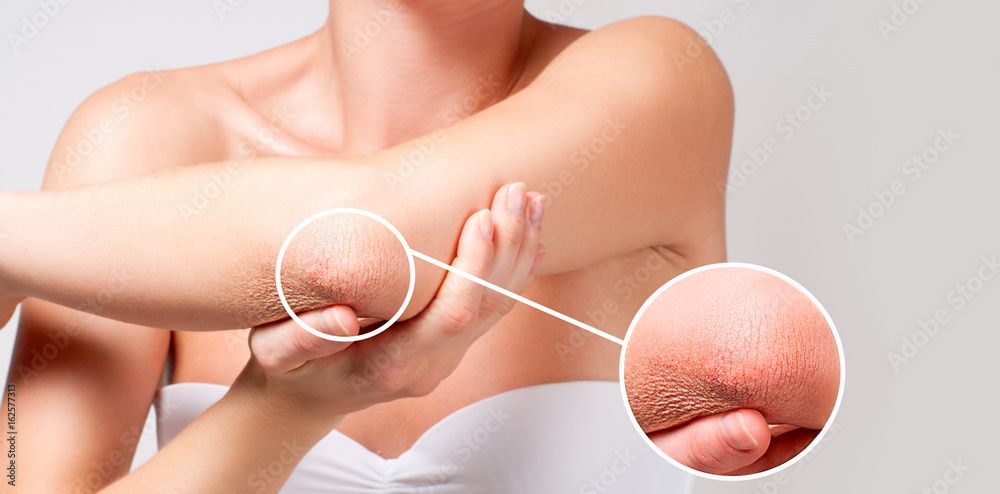Publication
Article
Pharmacy Times
Advise Patients on Routine Skin Care to Maintain Protective Barrier
Author(s):
OTC products can help winter-proof skin and prevent dermatological flare-ups
Xerosis or xeroderma, also known as dry skin, is a common occurrence characterized by a dull, cracked, rough appearance of the skin; skin tightening, flaking, and scaling; and, sometimes, pruritis.1,2 Although xerosis can occur anywhere on the skin, it most commonly occurs on the hands, feet, elbows, knees, and lower extremities.
Body care. Woman has dry skin on elbow. - Image credit: Dmytro Flisak | stock.adobe.com

There are a host of causes of xerosis, including aging; use of certain medications (ie, beta-blockers, contraceptives, diuretics, retinoids, long-term use of topical corticosteroids, antihyperlipidemic drugs, etc); radiation therapy for cancer treatment; excessive UV radiation exposure; frequent hot baths or showers; low humidity; cold temperatures; use of harsh cleansers; dehydration; malnutrition; contact with irritants; and hormonal factors (such as during pregnancy, menopause, and postmenopausal period). Certain medical conditions can also cause xerosis, including diabetes, cancer, cholestasis, renal failure, thyroid issues, and other autoimmune conditions.1,2 Patients with certain skin conditions, including seborrheic dermatitis, psoriasis, and atopic dermatitis, also report experiencing xerosis.1,2
Although most xerosis cases can be resolved with appropriate skin care, it can cause discomfort and inflammation and increase the risk of dermatological infections if left untreated.1,2 In general, the goals of treating xerosis include identifying the underlying causes, improving skin hydration, restoring the skin barrier function, and educating patients on prevention.1
Pharmacists will likely encounter patients seeking guidance on topical nonprescription products formulated for routine skin care maintenance, including cleansers and moisturizers. Several skin care products on the market are formulated to thwart and treat dry skin by restoring and maintaining skin hydration, including bath products, emollients, hydrating agents, and keratin-softening agents. Moisturizers are available in various formulations, including creams, lotions, gels, and ointments. Some products, such as skin protectants, topical hydrocortisone, and antipruritic products, are also available to shield dry skin and relieve inflammation, erythema, and itching.
RECENT CLINICAL DATA
In a publication in the Journal of Drugs in Dermatology, authors indicated that skin care products containing ceramides promote a healthy skin barrier. Additionally, use of ceramide-containing cleansers and moisturizers were linked with statistically noteworthy enhancements in diabetes-associated xerosis, physician- and subject-scored severity, patient satisfaction, and enhanced quality of life.3
In another study, authors indicated that adjunctive daily skin care throughout life helps maintain a healthy skin barrier and is useful in managing various inflammatory skin disorders in all populations. When selecting optimal treatment and skin care, prescribers should consider patient factors including age, skin properties, presentation of the condition, and cultural differences.4
HELPFUL PREVENTIVE AND TREATMENT MEASURES
Dermatology experts, including those from the American Academy of Dermatology, recommend the following measures to prevent and treat xerosis1,5:
- Take brief baths or showers daily with tepid (not hot) water.
- Use mild, fragrance- and alcohol-free cleansers because some skin care products, such as antibacterial washes, deodorants, and scented soaps, are too harsh for dry, sensitive skin.
- When drying skin, gently pat (rather than rub) the skin.
- Apply moisturizer immediately after washing to help retain existing moisture in the skin.
- Ointments or creams are more effective and less irritating than lotions.
- If needed, use a humidifier to add moisture to the air at home.
- Apply sunscreen daily when going outdoors.
- Stay hydrated by drinking at least 8 glasses of water daily if not contraindicated by a medical condition (eg, congestive heart failure or renal disease).
- If experiencing dry hands, apply moisturizers after washing hands and as needed.
Experts also indicate that if self-care measures are ineffective, patients should seek evaluation and care from a board-certified dermatologist.5
CONCLUSION
Although mild to moderate cases of xerosis can be effectively managed with appropriate skin care treatment and routine daily care, patients experiencing severe cases of xerosis or those with cases that appear to worsen or not improve after at least 7 days of self-care should be encouraged to seek care from a dermatologist. Pharmacists can also be instrumental in counseling patients about medications that may increase the risk of xerosis and provide information on preventive and treatment measures.
About the Author
Yvette C. Terrie, BSPHARM, RPH, is a consulting pharmacist and medical writer in Haymarket, Virginia.
References
- Benner KW. Atopic dermatitis and dry skin. In: Krinsky DL, Ferreri SP, Hemstreet BA, Hume AL, Rollins CJ, Tietze KJ, eds. Handbook of Nonprescription Drugs: An Interactive Approach to Self-Care. 20th ed. American Pharmacists Association; 2020.
- Gade A, Matin T, Rubenstein R. Xeroderma. In: Stat-Pearls. StatPearls Publishing; 2023. Updated October 29, 2023. Accessed November 22, 2023. https://www.ncbi.nlm.nih.gov/books/NBK565884/
- Kirsner R, Andriessen A. An international evaluation of a ceramide-containing hydrating cleanser and moisturizing cream for the improvement of diabetes mellitus-related xerosis. J Drugs Dermatol.2023;22(1):65-73. doi:10.36849/JDD.7168
- Schachner L, Alexis A, Andriessen A, et al. The importance of a healthy skin barrier from the cradle to the grave using ceramide-containing cleansers and moisturizers: a review and consensus. J Drugs Dermatol. 2023;22(2):SF344607s3-SF344607s14.
- Cold weather and your skin. American Academy of Dermatology Association. January 31, 2023. Accessed November 22, 2023. https://www.aad.org/news/coldweather-and-your-skin







